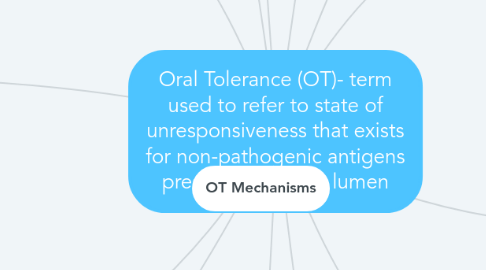
1. Role of gamma delta cells in OT
1.1. OT can be trasferred gamma delta CD8+ T cells
1.2. Only suppresses IgE and not IgG
1.3. Diabetes in non-obese diabetic mice can be prevented by transfer of tolerised CD8 gamma delta T cells
1.4. Can be prevented or abrogated by depleting gamma delta T cells
1.5. cannot be induced in d TcR KO mice
1.6. gamma delta T cells may suppress conventional Ag specific alpha beta T cells in an idiotype specific manner
2. Bystander Suppression
2.1. Associated with feeding of low doses of Ag
2.2. OT cells suppress proliferation of unrelated Ag-specific cells factor is soluble, TGF-B1
2.3. Factor is soluble, TGF-B1
2.4. Regulatory cells induced by OT secrete Ag non-specific cytokines following challenge by OT Ag
2.5. Suppress inflammation locally
3. OT Mechanisms
4. Oral Tolerance Features
4.1. Can be induced to both humoral and cell mediated immunity (CMI)
4.1.1. CMI is easier to tolerise than humoral responses and requires less antigen and lasts longer
4.2. All proteins can induce OT
4.3. Th1 responses are easier to tolerise than Th2 responses
4.4. Induces defective lymphocyte migration
4.5. Exhibits carrier specificity
4.5.1. Tolerance of antibody production can be broken if the defectie Th cells are bypassed with an unrelated carrier or LPS
4.6. Can be induced as quickly as 1-2 days after feeding and last +/- 18 months
4.7. Antigen persistence is required for maintenance
4.8. Effector functions (IgE and DTH) most associated with pathology are easisest to olerise
5. Result of innapropriate antigen presentation
5.1. Antigen-specific cytokine production in the absence of cell proliferation occurs
5.2. OT can be induced with peptides, enhanced availability of antigen to antigen presenting cell
5.3. OT is prevented if APC functions are activated
5.4. Presentation of antigen by non-costimulatory APC
5.5. Epithelial cells
5.5.1. express MHC class II but have low levels of CD80 and ICAM-1
5.5.2. May selectively present antigen to CD8 regulatory cells
5.5.3. May take up antigen and doesn't induce co-stimulatory molecules to induce immune response
5.6. Local presentation of antigen would induce local tolerance
5.7. Unusual population of APC in lipopolysaccharide and PP induce tolerance in naive recipients
5.8. Antigen-loaded dendritic cells Found in efferent intestinal lymph after feeding, expansion of DC enhances OT
6. Switching Th response
6.1. OT can be induced normally in anti-IL-4 treated or IL-4 KO mice
6.2. OT normal in IL-5 and IL-6 KO mice
6.3. IL-10 can restore tolerance to microflora
6.4. IL-10 KO mice develop IBD
6.5. IL-10 and IL-4 up-regulated following OT
6.6. Interferon gamma suppressed by OT, preceded by Ag-specific IFN-y response
7. Induction of Treg cells ( production of TGF-beta)
7.1. TFG-beta is abundant in gut
7.1.1. mediator of epithelial cell differentiation
7.1.2. Immunosuppresive
7.1.3. IgA class switching
7.2. Bystander suppression dependent on TGF-beta
7.3. TGF- beta Associated with prevention of colitis
7.4. TGF-beta Secreting CD4 and CD8 isolated from Peyers patch and mesenteric lymph nodes
7.5. TGF-beta Produced by TH3 Treg cells, macrophages,enterocytes
8. Brings problems when developing oral Vaccines
8.1. Oral vaccines against mucosal pathogens are desirable as they direct immune response where needed
8.2. No need for expensive and painful needles
8.3. Development of recombinant vaccines could be incorporated into transgenic plants
9. Clonal Deletion
9.1. High antigen dose
9.2. Mechanism of tolerance of self-reactive T cells
9.3. Uncommon after peripheral tolerance
9.4. High doses can induce apoptosis of responding T cells
10. Clonal Anergy
10.1. Low dose of antigen
10.2. Lacks inflammatory signals
10.3. Basic of peripheral tolerance to many self Ag
10.4. Can be reversed by addition of Il-2 and limiting dilution analysis
11. Reg T Cells
11.1. IL-10 and TGF-B enhanced following OT
11.2. Blocking TGF-B blocks oral tolerance
11.3. Treg cells secrete IL-10 and TGF-B
12. Role of CD4+ T Cells
12.1. Depletion of CD4 prevents OT
12.2. Tolerance can be transferred by CD4 cells
12.3. Preferential upregulation of T cell subsets
12.3.1. Q2Th2, increased, Th1 decreased
12.4. Th1 and Th2 dependent cytokine and antibody responses can be tolerised by different regimes
12.5. IgE is very susceptible to OT but IL-4 KO can be tolerised
12.6. CD4 Th3 cells, like Th2 cells produce Il-4 and Il-10 but also produce TGF-B
13. Gut Processing antigen in particular manner
13.1. Intestinal processing generates tolerogenic protein
13.2. Intact protein is absorbed from gut
13.3. Serum taken 1 hour after feeding can trasfer OT and inhibit delayed type hypersensitivty
13.4. Serum taken following antigen administration via routes cannot transfer tolerance
13.5. Tolerogenic material can't be transferred following feeding to SCID or irradiated mice
13.6. Intestinal filtration results in deaggregated monomers that are tolerogenic in other systems
13.7. Alterations in antigenic structure may be required, inhibition of pancreatic enzymes inhibits OT
14. Modulation of OT
14.1. Augmentas (enhances tolerance)
14.1.1. IL-2, IL4/IL10
14.1.2. Anti IL-12
14.1.3. Cholera toxin B subunit
14.1.4. LPS
14.1.5. IFN-beta
14.1.6. Multiple emulsions
14.2. Decreases
14.2.1. IFN-gamma
14.2.2. IL-12
14.2.3. Cholera toxin
14.2.4. Anti-MCP-1
14.2.5. Anti-gamma delta
14.2.6. Cyclophosphamide
14.2.7. Graft versus host disease
14.2.8. Parasite Infection

